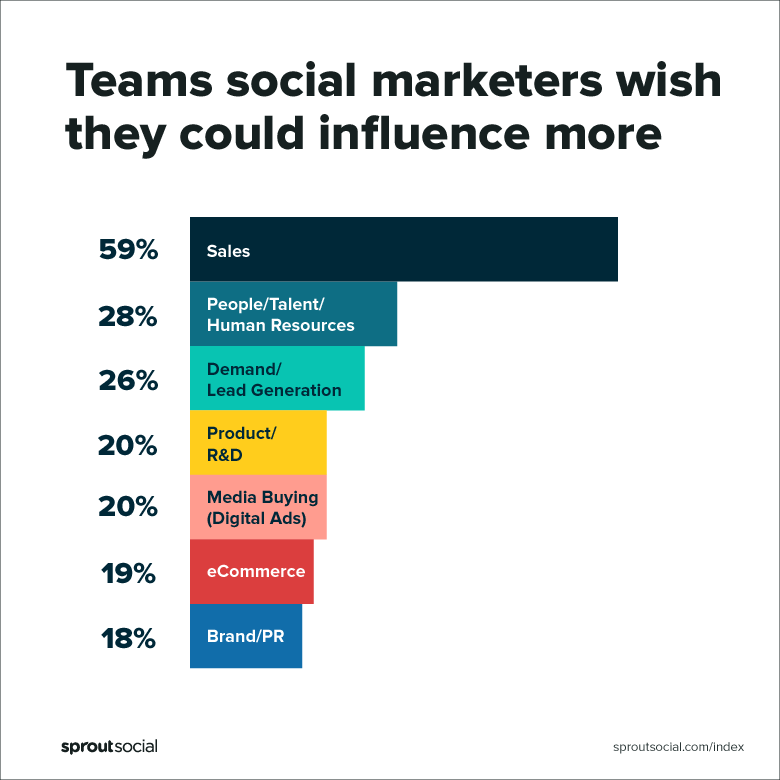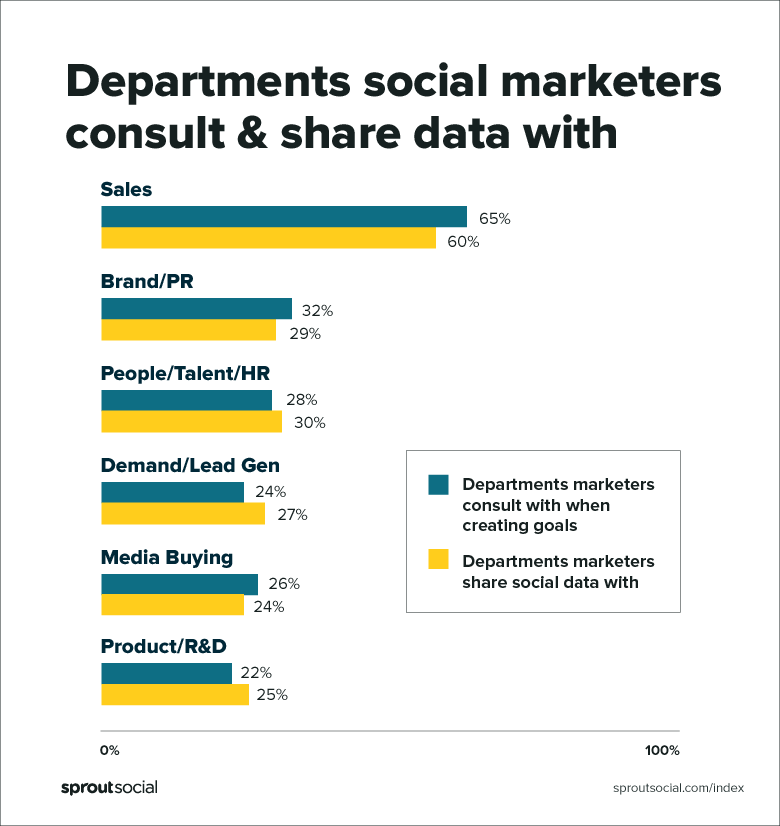Why you need to share social media reports, even if no one’s asking for them
For some social media managers, reporting comes with the job. For others, leadership may have a more hands-off approach, expecting the social team to “just put this on social.'
But making social media work is work, and measuring whether it’s happening requires at least a little analysis. Performing this analysis, and sharing it with managers, colleagues and leadership via a social media reporting system helps gauge the success of social marketing efforts and demonstrate that success to stakeholders.
Social media managers have much to gain from reporting, even in organizations where it isn’t expected. In fact, establishing a social media reporting cadence can help you overcome some of your biggest challenges.
A social media reporting system closes the gap
According to The 2019 Sprout Social Index™, social marketers by a long shot wish they could influence sales teams more than any other. Fifty-nine percent want to influence sales, double the number who want to influence either HR or lead generation teams.

In addition to craving more influence, social marketers also struggle to secure the budget and resources they need. Sprout’s research reveals that 33% of social media practitioners and 31% of social media leaders have this issue.

To resolve these shortages of influence, budget and resources, social media managers need data on their side. They also need to know how to present that data in a digestible way for others. Translating likes and shares into desired outcomes is the difference between an organization knowing they have a social media presence, and knowing that presence produces measurable results.
That translation requires a social media reporting system. A solid system is comprised of:
Which people/groups you’ll report toWhat goals or areas each of those groups needs information onThe social metrics you’ll report onThe tools you’ll useWhat your reporting cadence will beYour social media reporting cadence is your frequency; do you want to report weekly? Monthly? Quarterly? Perhaps different audiences—yourself, the team, management, leadership—benefit from different cadences. How often will you do a deep dive into reports? How often will you “spot check” for major swings? When do key metrics need to shift? We’ll suggest some tools to help figure all this out further down.
Social media managers have a unique understanding of how social marketing works. With a social media reporting system, you can foster understanding among other teams and stakeholders.
Social media reporting: extra work, but extra worth it
Is it worth taking on regular reporting if no one’s asking for it?
We think so. At minimum, a social media reporting cadence reveals what’s working and what isn’t on an ongoing basis so that you can make informed decisions. An uninformed social media strategy, after all, is a shot in the dark. Regular reporting sheds light on where your energy is best spent.
For example, the moment you see that a particular type of content performs better than others, you can begin leveraging that information and tailoring future content to maximize results. Then, you can track those results to make sure the pivot is paying off.
Additionally, a social media reporting system can help secure buy-in from decision-makers. Think hiring a video intern or increasing the budget for boosting posts would be a game-changer? You’ll need to convince leadership, and that’s best done with data.
Earning influence with data
For many social media managers, sharing data with sales is already a part of the job. In fact, sixty-five percent reported sharing data with sales in the Sprout Social Index.

Despite this, social marketers still crave more influence with sales teams. To close the gap, we need thoughtful data storytelling focused on audiences’ desired outcomes.
Not every stakeholder has the insight you have for interpreting social data. Churning out a spreadsheet every month or quarter and expecting others to decipher it isn’t likely to go far. Your reporting will need to go a little deeper, telling a story with the data to foster understanding and providing clarity around next steps that both your team and the reader can take. You’ll also want to use reports to document your wins and accomplishments along the way.
An interpretive social media reporting system will have a much greater impact than providing numbers without context, and increase your odds of garnering the influence and budget you need. Down the line, this reporting and documentation will also come in handy for conversations about things like career advancement.
Sharing data with team members, managers and leadership
Let’s explore an example of what social media reporting might look like.
While you may understand the value of engagement metrics, sales team members are more familiar with tracking things like win rates and deal size. You can meet these team members where they’re at by focusing on the places where social and sales collide. Ultimately, your common goal is serving your customers. Social data overwhelmingly tells you what is important to your audience. Your sales team needs to know that in order to make their offerings, outreach and conversations as valuable as possible.
For example, perhaps highlighting an advanced service on social platforms resulted in a measurable uptick in social messages from enterprise-level leads requesting more information. Once you have team members’ attention with a number that speaks to their goals, it’s easier to delve more deeply into how your specific social strategy fuels these successes and why intentional collaboration is important. It also begins to reveal the person “behind the curtain,” you, pulling the levers and turning the knobs that produce these results.
We can complain internal stakeholders “don’t get social” or we can bring them along
A few tactics our team deploys:
Daily huddles w emailed report outMonthly creative brainstormsQuarterly calls: lessons & winsAgency-led webinars Data Data DataPreach PreachPreach
— Jen Hartmann (@jenalyson) March 5, 2020














